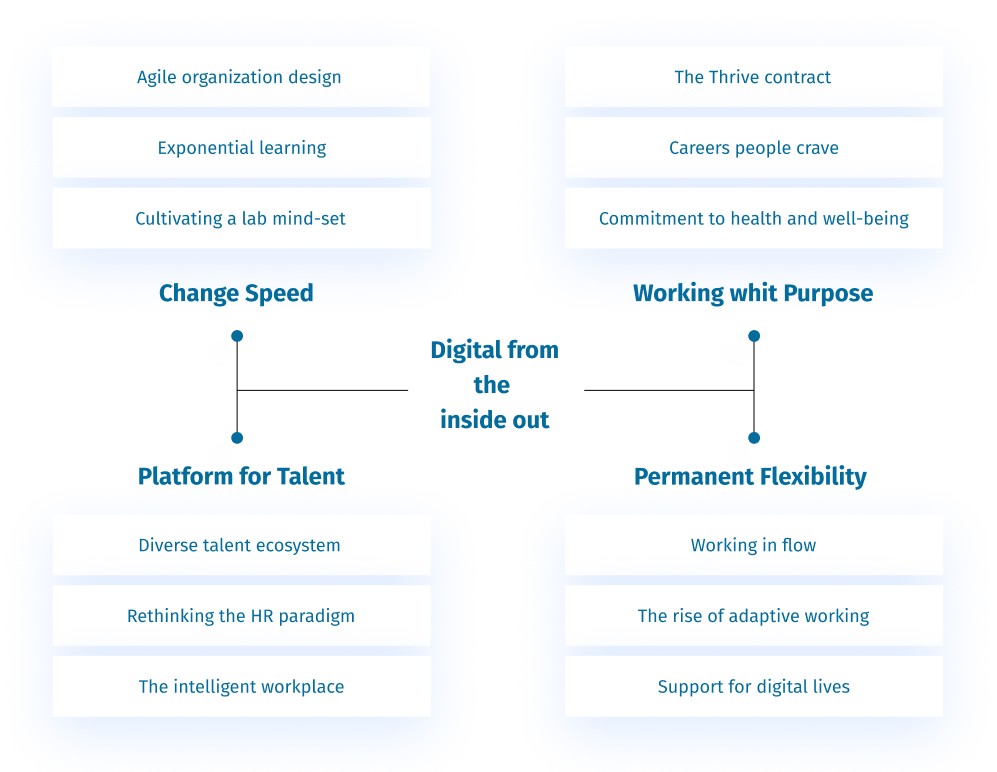Building a workforce for the future
So how does your organization get to that end state? We can take you through four steps that enable you to succeed.
What organizations really need is an expert to come in and do the full diagnostic assessment – to essentially take an x-ray of the organization – to look in detail at their current strategies and diagnose potential problems and barriers to development, and offer services and solutions to fix the problem.
Our’s vast experience within HR allows us not only to take the x-ray, but to effectively diagnose potential and actual problems within an organization; then, with a vast array of solutions and services, we can help you empower your workforce, and enable them to adapt agilely into the workforce of the future.
Insights like this will enable your organization to be a trend-setter for the workforce of the future, leaving you well ahead of your competitors.
Align
Set strategy to compete in a changing world
Define
Use data and insight to define supply and demand
Design
Define workforce strategies and solutions
Drive
Deliver on the plan speed and accuracy
How to unlock growth in human age?
Change@speed: the core competency organizations need to cultivate for sustained success is not designing the right future model, but being open to change, learning along the way and finding ways to take your people with you as you form and reform around shifting value drivers.
Working with Purpose: as jobs deconstruct and the value proposition shifts, organizations that are most attractive to employees are finding ways to design jobs that inspire people. They are intentionally creating careers they crave and actively supporting those in their ecosystem to achieve their health, wealth and career goals.
Permanent flexibility: in the era of the individual and with talent scarcity a top concern, embracing new work models is a win win. Designing for flexible working – adjusted hrs through to gig working should be a priority this year.
A platform for talent: The number one area that Executives believe will unlock value is a stronger ability to move people to jobs and jobs to people. Adopting a platform mindset shakes the current model of HR by challenging concepts around access to opportunity, ownership for data and what insights truly influence decision making.

One other finding from this year’s report is that it is pretty tough to achieve some of this without embracing digital ways of living and working.
What is interesting is that companies that are digital on the inside rate themselves as further along in their external digital journey, more agile in responding to change and better prepared for the future.
As Steven Hawking said: “The rise of artificial intelligence is likely to extend job destruction deep into the middle classes, with only the most caring, creative or supervisory roles remaining.”
Steven Hawking is certainly a heavy weight when it comes to predictions but he does not tell us a lot of detail here, in what time frame he thought when saying this for example. So it might be some more years down the road but there is certainly some issues emerging that we need to consider today.
And he adds his voice to a growing chorus of experts concerned about the effects that technology will have on workforce in the coming years and decades. The fear is that while artificial intelligence will bring radical increases in efficiency in industry, for ordinary people this will translate into unemployment and uncertainty, as their human jobs are replaced by machines.
As technological breakthroughs rapidly shift the frontier between the work tasks performed by humans and those performed by machines and algorithms, global labor markets are undergoing major transformations. These transformations, if managed wisely, could lead to a new age of good work, good jobs and improved quality of life for all, but if managed poorly, pose the risk of widening skills gaps, greater inequality and broader polarization. It won‘t be only job destruction – we will also have to think about how to reshape jobs.
If all this happens what are the implications for us working in C&B and how can we prepare? Well from a C&B perspective we will increasingly be asked to: formulate a comprehensive workforce strategy ready to meet the challenges of this new era of accelerating change and innovation. Understanding new talent ecosystems to drive the digital agenda, build vs buy vs borrow carefully listening on what employee groups value and then designing reward frameworks that support these trends and enabling to attract resources for the digital journey. And it won‘t be only job destruction – we will also have to think about how to reshape jobs.
In today’s era of volatility, there is no other way but to re-invent. The only sustainable advantage you can have over others is agility, that’s it. Because nothing else is sustainable, everything else you create, somebody else will replicate.
The last ten years of IT have been about changing the way people work. The next ten years of IT will be about transforming your business.